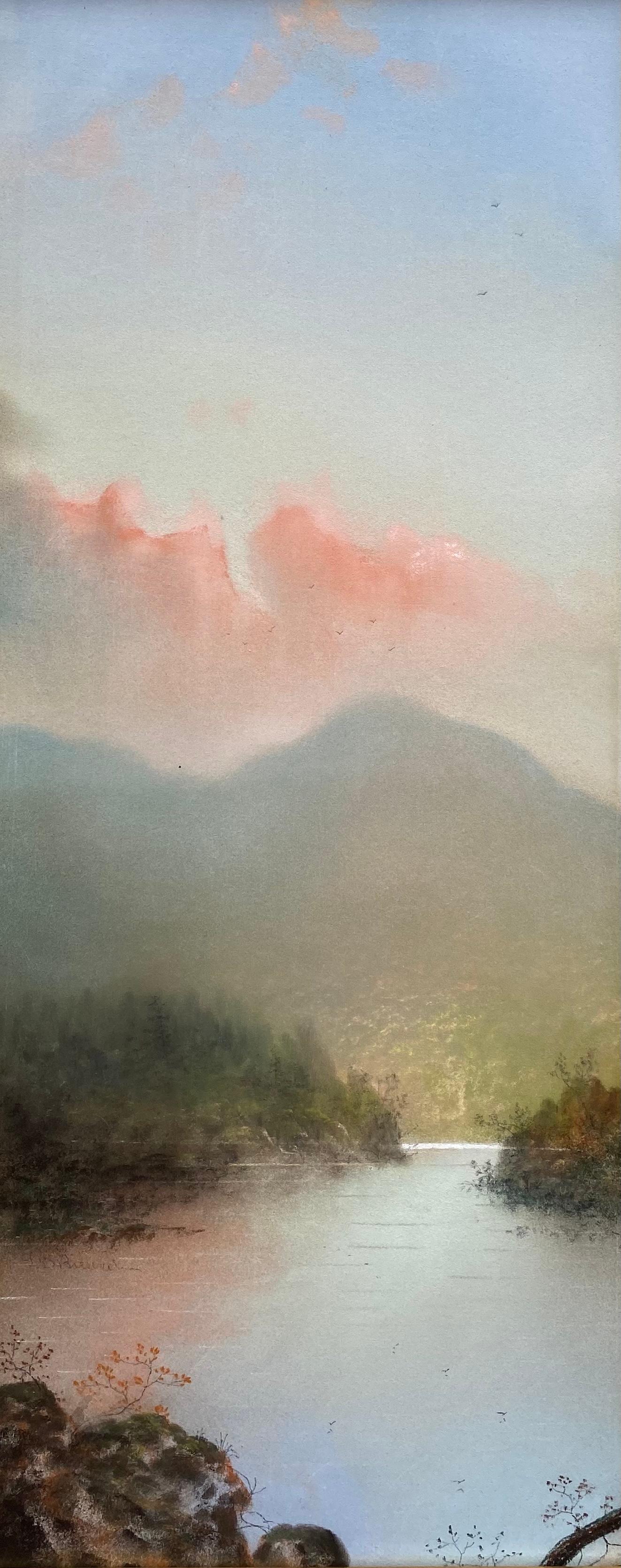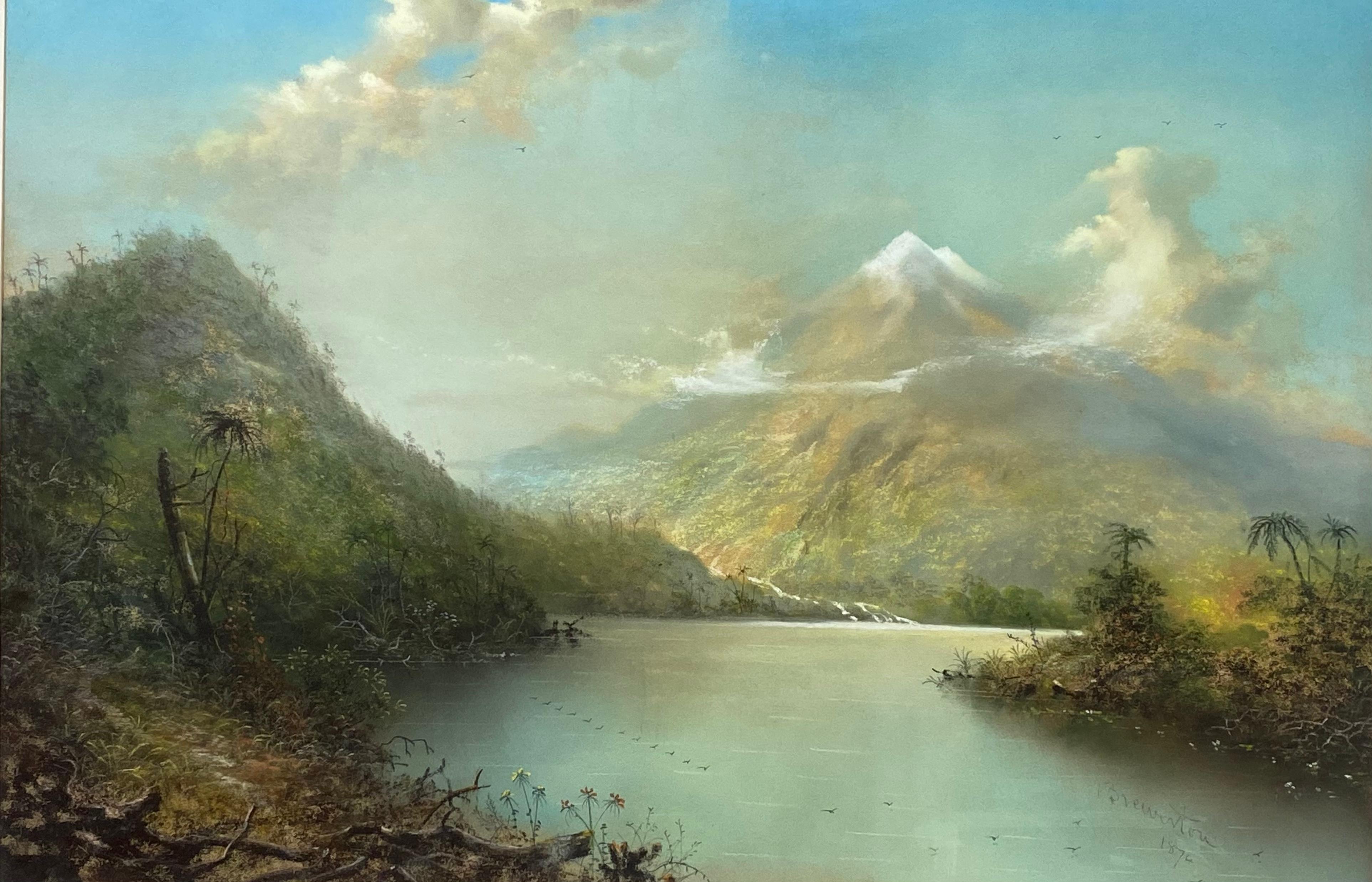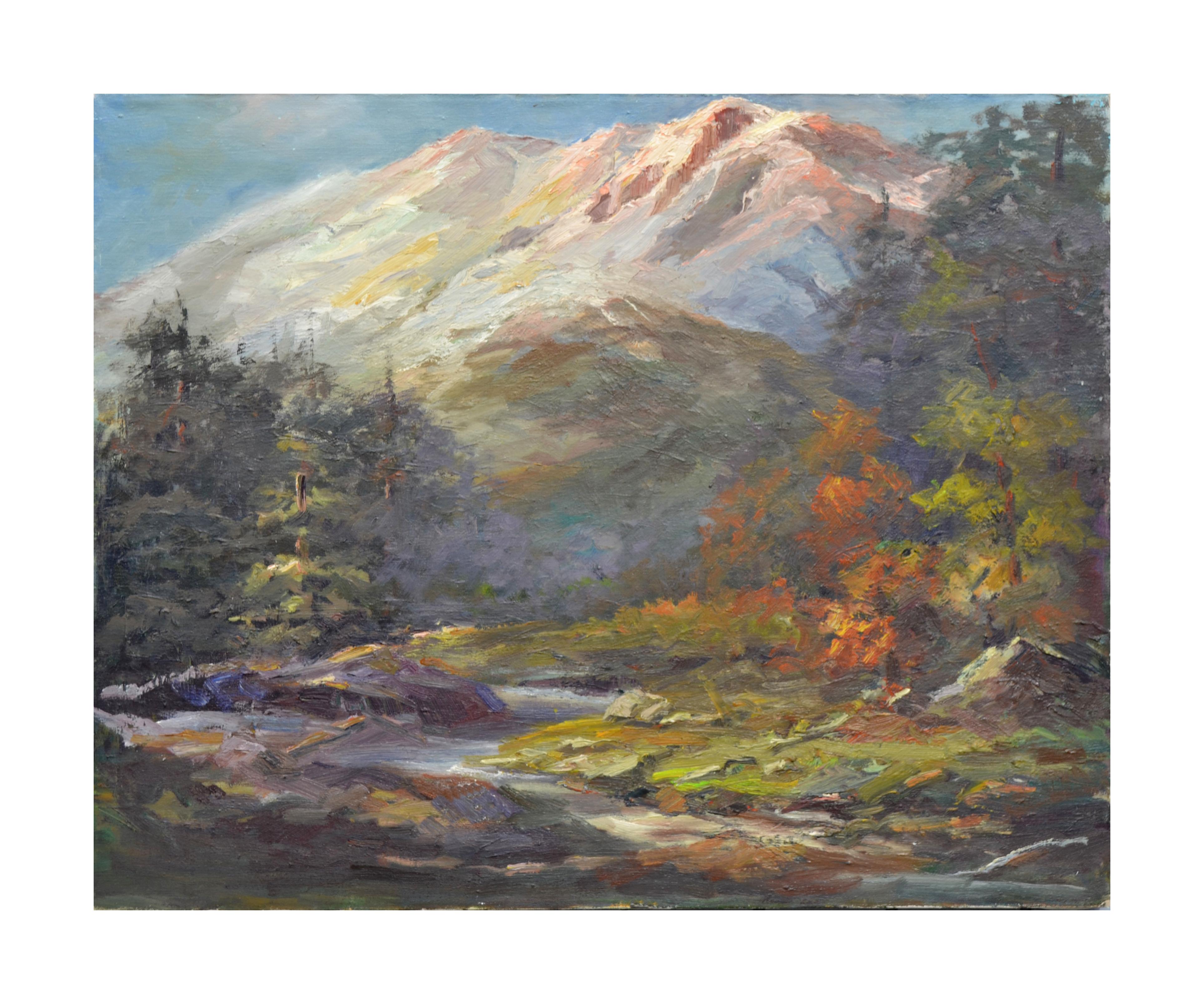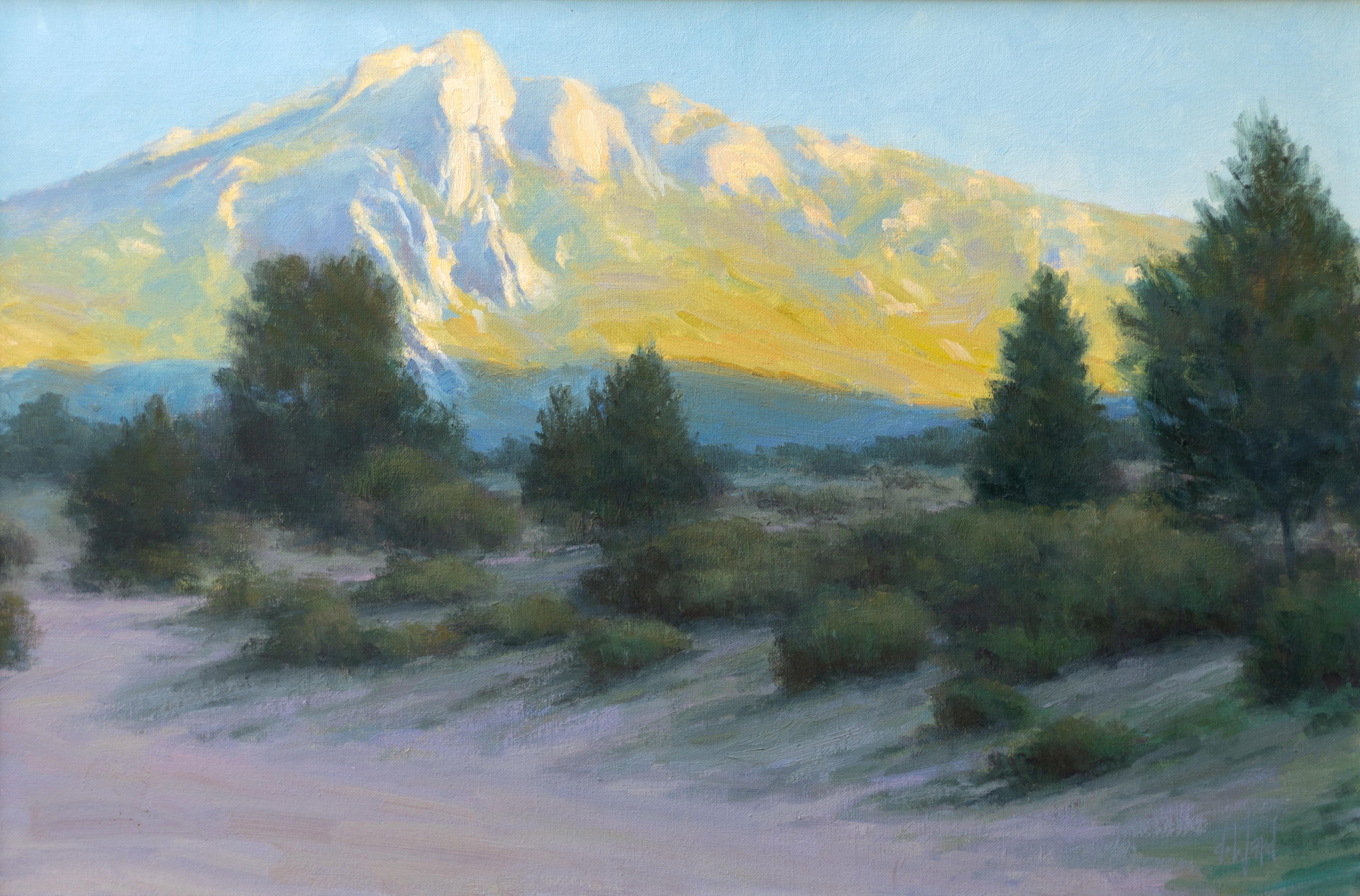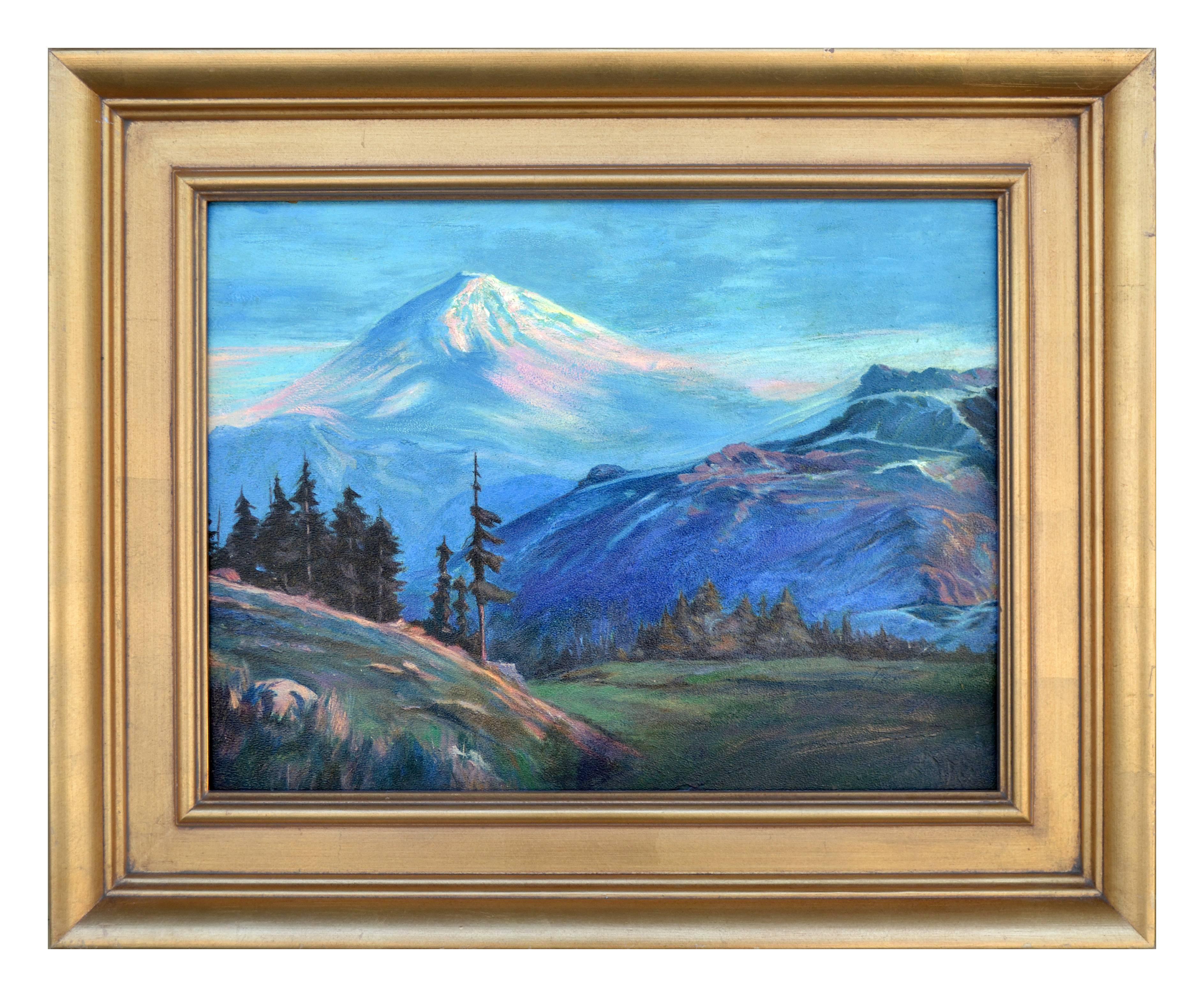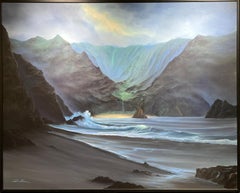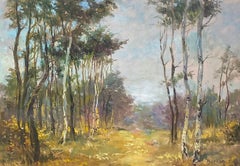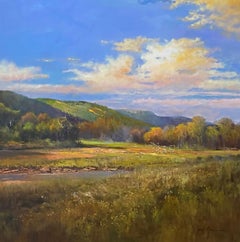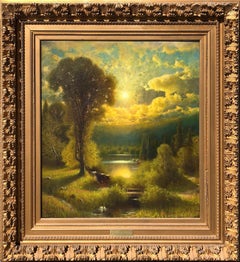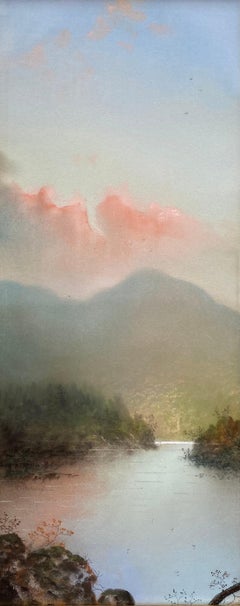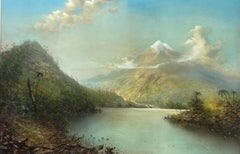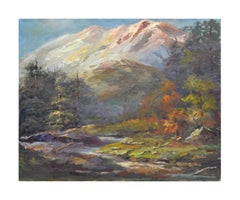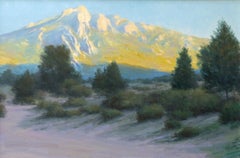Items Similar to Mt. Shasta, California
Video Loading
Want more images or videos?
Request additional images or videos from the seller
1 of 13
Eliza BarchusMt. Shasta, California
$5,500
£4,177.70
€4,814.13
CA$7,745.36
A$8,586.88
CHF 4,512.74
MX$105,089.32
NOK 56,359.54
SEK 52,899.06
DKK 35,934.46
About the Item
Eliza Barchus (American, 1857-1959)
Mt. Shasta, California
Signed Lower Left
Titled Verso
11 x 14 inches
13.75 x 16.75 inches with frame
Eliza Rosanna Lamb was born into the life of the raw Wild West in 1857. Her family generally led a nomadic life, frequently moving from town to town by wagon in search of work. For a period of time, her stepfather (her father died soon after she was born) led a colorful life as a US Deputy Marshal under "Wild Bill" Hickok. While a harsh childhood environment to be raised in, she learned the value of hard work, and which she would draw upon throughout her later life. In 1880, at the age of 22, she moved to Portland, Oregon, with her second new husband, John Barchus.
Settling in Portland was her first opportunity to lay down roots. It is likely that she had always dreamed of being an artist. Now, her husband likely gave her the encouragement and resources she needed to fulfill that desire. So in 1884 Barchus took what were probably her only lessons in painting. While Portland already supported several instructors of art, she chose to study under William S. Parrott, likely because she admired his work, both in subject matter - local landscape - and artistic style. She adopted many of his methods, resulting in her early work being quite similar to his. Even today, 'Barchus school' or 'Parrott school' are frequently used terms to describe paintings by turn-of-the-century Oregon artists that align with their style.
Within two years of her first lesson, Eliza commenced upon an art career that would ultimately span 50 years. In fact, by 1886 she had become an art instructor herself, advertised in The Oregonian daily newspaper that she had opened painting classes for young women, offering them at the "reduced rate of 50 cents" per lesson.
She also began submitting her work at local art fairs, including the Annual Portland Mechanics Fair held each fall. A newspaper reference of "Mrs. Barchus's (sic) specimens will be seen at the fair" indicates that she participated in the 1886 Fair. However, it was not until the next year that she hit gold earning the top prize for one of her landscape paintings! She was justifiably proud of her accomplishment. She later had the dime-size medal incorporated into a necklace, which can be seen in early photographs of the artist. In 1888 she was again recognized for her entries at the Fair with a silver medal.
With back-to-back medal honors, and local encouragement, Barchus decided to submit an entry to National Academy of Design's 1890 fall show in New York City. In route to the exhibition, Barchus had a chance encounter in Chicago with Henry Pittock (who later built the Pittock Mansion). He gave her encouragement for her journey and wish of success. At 32 years of age and just six years after starting her career, Barchus had now exhibited at one of America's most prestigious art association.
While Barchus was establishing herself as an artist, family commitments were also growing. Two children were born in the early 1890's, which undoubtedly demanded her maternal attention. Additionally, her husband's health began to deteriorate from Brights disease (a kidney ailment), and he died in 1899. Therefore, her talent in painting soon became the sole livelihood for the family.
At a time when most women did not work, Barchus became a very adept and enterprising businesswoman. Remarkably, starting in 1891, she arranged for six homes to be built for her family in over a span of about twenty years. Construction costs were frequently paid by barter of her paintings rather than cash. Four of these southeast Portland homes are still in use today.
Her savvy was not limited to domestic activities. She was a keeper of a downtown Portland art studio during this period. Her first studio was in the prominent Dekum building and later moved to the Multnomah building. Additionally, she arranged to have examples of her work displayed at other business establishments, including the local cigar & newspaper concessionaire B.B. Rich in at the famous Portland Hotel when it opened in 1890.
With the growing need to support a family, and to assure enough supply of paintings for her flourishing tourist sales, Barchus began to produce standard sizes of popular northwest scenery in assembly-line type fashion. A collection of similarly unfinished paintings illustrate that she would work on ten or more paintings of a single scene at the same time: first painting the sky, then the background, and then moving toward the foreground with various layers of paint, likely letting each previous effort dry before beginning the next. She now reduced the detail elements that her earlier paintings had and a the "'Barchus'" style developed appeared in her work. Popular scenes included the tremendous geologic formations of the region: local mountains (Mount Hood, Mount Rainier, Mount St. Helens, and Mount Three Sisters), Multnomah Falls, Rooster Rock and Crater Lake.
At arguably the peak of her career, Portland played host to the world with the 1905 Lewis and Clark Centennial Exposition and Oriental Fair. Barchus obtained a concessionaire's booth to sell paintings in the fair grounds. In anticipation, she had color reproductions of her paintings printed that were offered at the fair for a seemingly high price of 75 cents (an original painting could be purchased for $3.50). These lithographs later evolved into successful postcard sales for many years afterwards. At the end of the Fair, Barchus again earned recognition by being awarded a the gold medal for the best collection of paintings of Pacific Coast scenery.
Helen Barchus was primarily a studio painter and used photographs or literary descriptions as the source of many of her compositions. However, she did enjoy to traveling and such trips tended to be for the purpose of painting. The normal output of such a trip for an artist would typically be sketches that would later be used to complete finished oils upon return to the studio. However, it does not appear that Barchus produced sketches as none have been located. Therefore, it can be assumed that she completed paintings while on these trips, which she used for subsequent paintings. (This would explain the large variety of scenery still intact in the artist's collection at the time she finally laid down her brushes and pallet in the mid 1930's.) Leaving her children behind, she traveled to New York City (1890), Glacier National Park and Yellowstone Park (1901), Alaska (1913), and Yosemite (1914), each of which resulted in fresh scenery for her to paint.
Remarkably, Barchus found time for leisurely pursuits. One was writing poetry. These covered a variety of topics, including war, friendship, and of course, nature's beauty. Many she copyrighted, sometimes using her maiden name of Rosanna Lamb as a pseudonym - Rosanna Lamb. And for some, at the cost of $24, she engaged the music publishing company, Knickerbocker Harmony Studios of New York, to have melodies composed and created for them, including such poems as "When Our Eagle Gets Bill's Goat" and "Over the Hindenburg Lane". She incorporated some of these creative writings incorporated into her advertising material that promoted the sale of paintings.
By the late 1920's Barchus was in her 70's. Her eyesight began to fail her and arthritis progressively became a problem. The quality of her paintings correspondingly suffered from crude execution of brush stroke and lack of color blending. By the mid 30's she acknowledged that her facilities would no longer enable her to continue painting. After fifty years, and literally thousands of paintings- possibly as many as 7,500, she quietly laid down her pallet and brushes. She died several years later, in 1959, at the age of 102.
With unwavering support, the artist's daughter continued to promote her mother's work. The purpose was likely two-fold. First, there was a large inventory of unsold paintings that needed to be sold. Second was her desire to honor the artistic contribution her mother made to the state. She was ultimately successful in both. In 1971 the Oregon State Legislature passed a resolution giving Eliza Barchus the honorary title of The Oregon Artist. Additionally, in 1974 she authored a biography about her mother's life. Unfortunately for Oregon, about this same time she sold, in mass, a significant portion of the unsold inventory, including some that were prize pieces and covered the span of her career, to an East Coast collector.
- Creator:Eliza Barchus (1857 - 1959)
- Dimensions:Height: 11 in (27.94 cm)Width: 14 in (35.56 cm)
- Medium:
- Movement & Style:
- Period:
- Condition:
- Gallery Location:Missouri, MO
- Reference Number:1stDibs: LU747314542972
About the Seller
5.0
Vetted Professional Seller
Every seller passes strict standards for authenticity and reliability
Established in 1970
1stDibs seller since 2017
155 sales on 1stDibs
Typical response time: 1 to 2 days
- ShippingRetrieving quote...Shipping from: Missouri, MO
- Return Policy
Authenticity Guarantee
In the unlikely event there’s an issue with an item’s authenticity, contact us within 1 year for a full refund. DetailsMoney-Back Guarantee
If your item is not as described, is damaged in transit, or does not arrive, contact us within 7 days for a full refund. Details24-Hour Cancellation
You have a 24-hour grace period in which to reconsider your purchase, with no questions asked.Vetted Professional Sellers
Our world-class sellers must adhere to strict standards for service and quality, maintaining the integrity of our listings.Price-Match Guarantee
If you find that a seller listed the same item for a lower price elsewhere, we’ll match it.Trusted Global Delivery
Our best-in-class carrier network provides specialized shipping options worldwide, including custom delivery.More From This Seller
View AllA Place Without Time
Located in Missouri, MO
A Place Without Time
Michael Protiva (20th/21st Century)
Signed Lower Left
48 x 60 inches
49.25 x 61.25 inches with frame
Michael Protiva's interest i...
Category
21st Century and Contemporary Contemporary Landscape Paintings
Materials
Canvas, Oil
Lonesome Woods
By Mark Kaplan
Located in Missouri, MO
Landscape
By Mark Kaplan (Russian, b. 1950)
Signed Lower Right
Unframed 7" x 9"
Framed: 20.25" x 16.25"
Mark Kaplan was born in 1950 in Saint Petersburg ...
Category
20th Century Impressionist Landscape Paintings
Materials
Paper, Oil
Price Upon Request
River Access
By Joseph Orr
Located in Missouri, MO
Joseph Orr (Japanese, American, b. 1949)
River Access
Signed Lower Right
30 x 30 inches
39.5 x 39.5 inches with frame
BORN in Tokyo, Japan, Oct 31,1949, Joseph lived his first years in an orphanage sponsored by American Armed Forces. He was adopted April,1954 and came to the US at age 5 where he became an American citizen. As the Orr’s traveled for the US military Joseph enjoyed a childhood rich in experiences from Germany and back to California where he attended High School and started College.
Following his parents to Missouri In 1971 he took a job with Hallmark Cards as machine operator in the cardboard fold dept. It sparked an interest in art, so after a few months he sought out some of the Hallmark artists at their work for private lessons. He learned basic drawing and watercolor from Anthony Allison and, “Probably before I was ready”, he admits, Joseph was entering local art shows and even winning prizes. At that time Joseph also enrolled for art instruction under John Coleman at Longview Community College. He spent one semester there.
By the end of 1972 Joseph had quit his day job to become a full time painter, joining an art show tour group called Word Of Art, which was a new concept: culture meets promotion. Booking weekly art exhibits in the new indoor shopping malls across America, The idea transformed part of the art world by bringing art to the masses.
For Joe and many other artists in the early 1970’s, it created the chance to paint full time and sell their work to an otherwise unobtainable audience. During this time of continuous self study and painting Joseph transitioned from watercolor to the newer acrylic painting medium.
Believing that acrylic, as a fine art painting medium, can be as viable as oil, Orr has always promoted it as the modern medium that it is.
In 1990 Joseph, along with his wife, Rita and two other artists, founded the National Oil & Acrylic Painter’s Society. The Orr’s brainchild, they were aided in founding NOAPS organization by local art patrons, Wm & Martha Mitchell and fellow artists Pete Peterson and Dennis T. Yates.
While traveling with the World of Art Tour Joseph had met Rita Mathews, an aspiring artist, in Columbia, MO. They were married in June 1974 and stayed in Missouri, traveling and exhibiting their art together. Orr had a brief encounter with printmaking in 1977. He took private instruction in stone lithography and copper plate etching from Frank Stack, professor of art at the Univ of MO, Columbia, but painting remained his principal devotion.
By 1999 Joseph had become proficient enough to have obtained Gallery representation with several Fine Art Galleries across the US.
Joseph Orr currently resides in Osage Beach, Missouri, but travels to paint and visit his gallery representatives and Exhibit Openings.
PHILOSOPHY:
For me the idea is that painting should follow some form of illustration and truth telling. Basically, the premise of my painting philosophy, is to build layers of narrative into my paintings. A place or landscape scene is never defined satisfactorily without it’s relationship to color and composition. It is important to balance fact with imagination.
“ART REFLECTS THE SOUL OF SOCIETY. A JUDGMENT CAN BE MADE FOR THE ATTITUDE OR CONDITION OF SOCIETY BY INSPECTING THE POPULAR ‘IDEAS’ OF ART OR, IN SOME INSTANCES, THE LACK OF ART.” (JOSEPH C. ORR)
NOTED SOLO EXHIBITS :
*BIRGER SANDZEN MEMORIAL, LINDSBORG, KS;
*HARWELL ART MUSEUM, POPLAR BLUFF, MO;
*ASHBY-HODGE GALLERY OF AMERICAN FINE ART, FAYETTE, MO;
*NORFOLK ART CENTER, NORFOLK, NE;
*KODNER GALLERIES...
Category
20th Century Contemporary Landscape Paintings
Materials
Canvas, Acrylic
$10,000
Sunset
By James Fairman
Located in Missouri, MO
James Fairman
"Sunset" c. 1880
Oil on Canvas
Signed Lower Left
Site: 32.5 x 29.5 inches
Framed: 46 x 42 inches
James Fairman worked as a landscape painter, critic, lecturer, musicia...
Category
1880s American Realist Landscape Paintings
Materials
Canvas, Oil
Price Upon Request
Mountain Wall
By Carl Holty
Located in Missouri, MO
Carl Holty (1900-1973)
"Mountain Wall" 1962
Unframed: 12" x 9"
Framed: 19.5" x 16.5"
Signed Lower Left
Known for his floating, luminous, highly-colorful forms, Carl Holty belongs to...
Category
20th Century Abstract Abstract Paintings
Materials
Oil, Panel
The Home Place
By Joseph Orr
Located in Missouri, MO
Joseph Orr (b. 1949)
"The Home Place"
Acrylic on Canvas
Canvas Size: 9 x 12
Framed Size: approx 12 x 16
Joseph Orr, from Missouri, has been painting profes...
Category
2010s American Realist Landscape Paintings
Materials
Canvas, Acrylic
You May Also Like
“View of Mount Shasta, California”
Located in Southampton, NY
Original pastel on heavy card stock (made in Paris) by the well known Hudson River artist, George Douglas Brewerton. A view of Mount Shasta in Northern California. Signed lower left. Circa 1880. Condition is excellent. The artwork is housed in its original scroll decorated frame. Overall framed measurements are 33.25 by 19 inches. Provenance: A East Coast Florida estate.
George Douglas Brewerton received lessons in art from Prof. Robert W. Weir at West Point where his father was Superintendent. In 1874, he was detailed to San Francisco as an officer in the Stevenson Regiment. In 1848, he underwent many adventures in Western deserts and mountains with Kit Carson, who crossed the country with news of the California Gold Rush. After serving as an aide to Gen. Rufus Saxton during the Civil War, Brewerton called himself “Colonel,” although he never received an army commission...
Category
1870s Hudson River School Landscape Drawings and Watercolors
Materials
Pastel, Archival Paper
$2,240 Sale Price
20% Off
“View of Mount Shasta, California”
Located in Southampton, NY
Beautiful original pastel on archival paper of Mount Shasta in Northern California by the well known Hudson River artist, George Douglas. Signed and dated 1874 lower right. Condition is excellent. Recently professionally matted and framed in a antique silver style gallery frame. Overall framed measurements are 27 by 36 inches. Under glass. Provenance: A Pennsylvania collector.
George Douglas Brewerton received lessons in art from Prof. Robert W. Weir at West Point where his father was Superintendent. In 1874, he was detailed to San Francisco as an officer in the Stevenson Regiment. In 1848, he underwent many adventures in Western deserts and mountains with Kit Carson, who crossed the country with news of the California Gold Rush. After serving as an aide to Gen. Rufus Saxton during the Civil War, Brewerton called himself “Colonel,” although he never received an army commission...
Category
1870s Hudson River School Landscape Drawings and Watercolors
Materials
Pastel, Archival Paper
$4,800 Sale Price
20% Off
Mid Century Sierra Mountain California Landscape
Located in Soquel, CA
Beautiful mid century impasto landscape of tall trees and mountain peaks in the Sierras by an unknown California artist (American, 20th Century). Unsigned and unframed. Image size: 2...
Category
1960s American Impressionist Landscape Paintings
Materials
Canvas, Oil
Rocky Mountain
Located in Austin, TX
Title: "Rocky Mountain"
Artist: Don Ward
Medium: Oil on Canvas
Size: 24" x 36"
Category
21st Century and Contemporary Landscape Paintings
Materials
Canvas, Oil
$4,800
Early 20th Century Mt. Shasta Landscape
By Lorenz E. Griffith
Located in Soquel, CA
A beautiful and substantial painting of a distant view of snow capped Mount Shasta "in the style of" Lorenz Griffith (American, 1889-1968). Unsigned. Disp...
Category
Early 1900s American Impressionist Landscape Paintings
Materials
Canvas, Oil, Cardboard
$1,996 Sale Price
20% Off
Yosemite High Sierra Sunrise - Midcentury Landscape
Located in Soquel, CA
Luminous mid century landscape of the sun rising in the Yosemite High Sierras by an unknown artist (American, 20th Century). Unsigned. Unframed. Image siz...
Category
Mid-20th Century Modern Landscape Paintings
Materials
Canvas, Oil, Illustration Board
More Ways To Browse
Antique Reproduction Paintings
19th Century Oriental Paintings
Yosemite Painting
Helen Silver Artist
Helen Young
Cigar Painting
Pacific Northwest Landscapes
Antique Pallet
Antique Pallets
1920s California Landscape Paintings
The Music Lesson
Glacier Painting
Maiden Home
Yosemite Oil Painting
Dior Postcards
Framed Rooster Painting
Oregon Coast Oil Painting
Antique Eagle Painting
